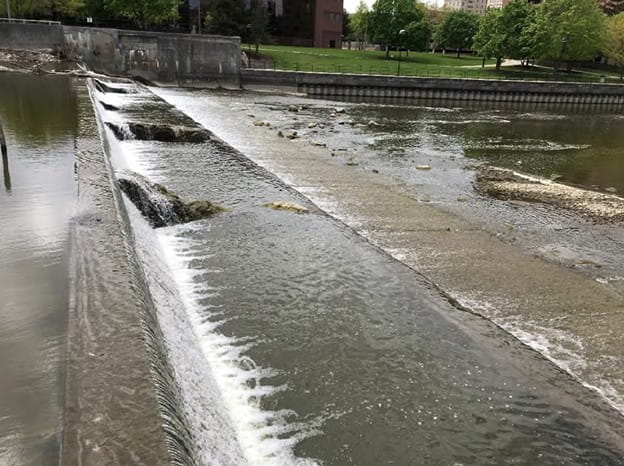The web Browser you are currently using is unsupported, and some features of this site may not work as intended. Please update to a modern browser such as Chrome, Firefox or Edge to experience all features Michigan.gov has to offer.
$1.5M grant will help remove 'high-hazard' dam from downtown Flint
May 30, 2023
As part of National Dam Safety Awareness Day tomorrow, MI Environment is highlighting Michigan’s Dam Risk Reduction Grant Program. The Michigan Department of Environment, Great Lakes, and Energy (EGLE) recently announced that 16 Michigan dams will receive grant funding to help reduce risks and protect residents.
For more than a century, just upstream from the heart of downtown Flint, the Hamilton Dam has disrupted the Flint River’s natural course. Those long years are finally coming to an end.

Hamilton Dam in Flint.
With $1.5 million awarded through Michigan’s Dam Risk Reduction Grant Program (DRRGP), Genesee County Parks and Recreation soon will begin removing the last crumbling remnants of the concrete dam and restoring the river channel with five natural rock riffles so fish can pass through unimpeded. Kayakers, too.
“This grant will make a substantial impact by restoring the natural flow of the Flint River, improving fish habitat, and creating new recreational opportunities for the residents of Flint and surrounding communities,” said Barry June, director of the Genesee County Parks and Recreation Commission (GCPRC). “The project will reconnect Lake Huron to the Flint River above Hamilton Dam for the first time in 100 years and support spawning runs of lake sturgeon and walleye, as well as allowing recreational navigation of the river.”
In all, the state grant program awarded $15.3 million to improve safety at 16 Michigan dam sites (locations listed below). A separate $855,650 federal grant announced in April 2022 – funded through the Bipartisan Infrastructure Law and managed by the GCPRC – will also help fund the Hamilton Dam removal as part of the ongoing Flint River Restoration Project.
Built in 1920, Hamilton Dam has a history that spans lumber milling, providing a water source for local industry, and regulating the river’s flow. In the 1960s, it became the upstream anchor point for an extensive downtown flood control project. But the structure deteriorated over time, with engineers warning since the late 1980s of the dam’s potential failure. The then-Michigan Department of Natural Resources and Environment ultimately assigned it a “high hazard potential” rating and an “unsatisfactory” condition assessment and mandated its replacement.
“High hazard would be significant environmental, economic, or flooding impacts,” said Luke Trumble, supervisor for the Dam Safety Unit at the Michigan Department of Environment, Great Lakes, and Energy (EGLE).
In 2018, the dam’s failing upper structure and floodgates were removed, leaving water to flow over a low-stepped concrete wall, or weir. It remains classified as a high-hazard dam, with sinkholes, seepage, settling concrete, and age-related deterioration. Its demolition will remove a barrier keeping fish from 25 miles of the river – including five miles of habitat for lake sturgeon, a fish the Michigan Department of Natural Resources is working to rehabilitate. Accompanying restoration will enhance the instream habitat and return the river to more natural conditions. The work is expected to take several years.
“Removal of the weir will enhance lake sturgeon restoration efforts in both the Flint and Saginaw river watersheds by creating additional rearing habitat for juvenile lake sturgeon above the barrier and spawning habitat for returning adults,” U.S. Fish and Wildlife Service project leader Scott Koproski told the University of Michigan-Flint, whose campus hugs the Flint River above and below the dam.
The Michigan Legislature authorized the DRRGP last year. Administered through EGLE, it aims to supply private owners with resources for proper management of existing dams and reduce the overall risk of dam failure in Michigan.
In addition to Hamilton Dam, DRRGP funding will support dam safety projects in Albion, Alger, Baldwin, Brooklyn, Clarkston, Holly, Manchester, Marquette, Republic, Rose City, Saline, Tecumseh, White Cloud, and Ypsilanti.
Additional funding opportunities for dam risk reduction will be announced publicly when they are ready for applicants.